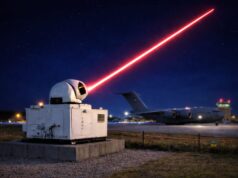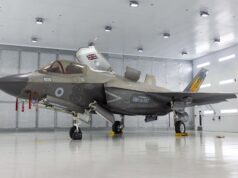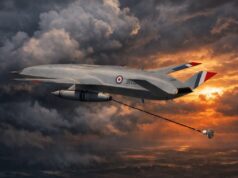Sikorsky has introduced RAIDER X, its concept for a coaxial helicopter specifically designed as a Light-Attack Reconnaissance Helicopter.
The aircraft is being offered through the US Army’s Future Attack Reconnaissance Aircraft (FARA) programme.
“RAIDER X converges everything we’ve learned in years of developing, testing and refining X2 Technology and delivers warfighters a dominant, survivable and intelligent system that will excel in tomorrow’s battlespace where aviation overmatch is critical,” said Frank St. John, executive vice president of Lockheed Martin Rotary and Mission Systems.
“The X2 Technology family of aircraft is a low-risk solution and is scalable based on our customers’ requirements”.
To date, the firm say that X2 aircraft have achieved/demonstrated:
- Speeds in excess of 250 knots
- High altitude operations in excess of 9,000 feet
- Low-speed and high-speed maneuver envelopes out to 60+ degrees angle of bank
- ADS-33B (Aeronautical Design Standard) Level 1 handling qualities with multiple pilots
- Flight controls optimization and vibration mitigation
“The power of X2 is game changing. It combines the best elements of low-speed helicopter performance with the cruise performance of an airplane,” said Sikorsky experimental test pilot Bill Fell, a retired US Army pilot who has flown nearly every RAIDER test flight.
“Every flight we take in our S-97 RAIDER today reduces risk and optimizes our FARA prototype, RAIDER X.”
The aircraft will be competing against the Invictus.













Why is no-one looking at an aircraft based on the Fairy/Westlands Rotodyne concept, especially Leonardo?
A convertiplane with a variable speed single main rotor with a pusher propeller, that has a main wing which offsets lift by at least 50%, will easily attain 300 knots on the same power used by the Raider. It will also fly further and higher than a comparable powered coaxial helicopter or tilt-rotor.
The Rotadyne based on a documentary I watched was very noisy had serious vibration problems and I may be wrong but wasn’t especially efficient falling between that area where you arguably get more of the bad aspects than the good ones of its two parents. Now that might be appreciably due to it being before its time and under developed but I thought that the modern tilt rotors are essentially a concept that tries to reverse those debilitating factors but I don’t have a direct comparison of the two concepts to confirm that. It’s just that I find it difficult to believe that aeronautical engineers would go to all the trouble and complexity of developing a tilt rotor if a far simpler concept would perform as well or better. Surely lift capability would be bettered by a tilt rotor over a Rotodyne type machine for example, as its using all its propulsion to do so.
That said surely the Airbus prototypes if I remember their configuration correctly at least, are to a degree using the same basic concept as a Rotodyne so someone sees the logic, at least in the Raider class if not heavier craft.
Actually just read up on the Rotodyne, it was rather more impressive than I had realised actually, hadn’t realised its main designer was the pre war Cierva autogiro guy. But the thing that caught my eye was its precursor the Gyrodyne. Check it out it is almost identical to the Eurocopter X3 which is the aircraft I was thinking of above.
I said concept not aircraft.
A helicopter with a single main rotor disc uses it for both lift and thrust, about 15% of the available power is taken to provide an anti-torque reaction to drive a tail rotor. On most normal helicopters the tail rotor is parasitic in that apart from providing anti-torque, at greater than 65% forward airspeed it has little use. The Blackhawk series of helicopters tilt the tail rotor so it provides a bit of extra lift, but only around 3%.
As the helicopter’s forward airspeed builds up, the blade tip will be going significantly faster than the fuselage. As the helicopter goes above 160 kts the tips depending on local air temperature and pressure will be in the transonic zone, as it goes faster, say over 175kts the tips may be going supersonic. A helicopter’s main rotor blade has to be relatively stiff but still have some flex in it. This is to compensate for lifting heavy loads and coping with air pockets etc. For a wing to go through the “sound barrier” it has to be very strong but also stiff. If a helicopter’s blade was designed to go supersonic it would fracture as soon as you started loading it up (never mind the noise). The other issue is the tip profile is not designed to provide lift with supersonic air. As the blades local airspeed speeds up to supersonic, it will start detaching itself from the surface creating vortices and air pockets. This cancels the tips ability to provide lift and drag starts rising exponentially. To get round this problem manufacturers have been giving blades swept tips, trying to delay the onset of the air going supersonic. Westlands took this a step further by designing a tip that could still provide lift in the transonic zone, but also generate less drag subsonically, it is not designed to be supersonic. The other issue is the discrepancy between the rotor blade that is advancing through the air and one that is retreating through the air. The one advancing through the air will generate more lift than the other, this in effect tilts the aircraft and gets worse the faster you go. Modern helicopters rely of flight stabs to control this. So basically a helicopter’s forward speed reaches a natural barrier where the blades stop generating lift and promoting drag, thus preventing it going any faster.
The Boeing/Sikorsky Defiant uses a co-axial rotor head. This addresses the issues of an advancing blade generating more lift than a retreating blade. As you have two opposing blades generating lift etc. It makes the aircraft have a small rotor disc and by using differential collective means it is very agile. The problem of generating more forward speed has not gone away, the blades are still the limiting factor. However, the Defiant uses brute force to go faster. It has a massive pusher propeller, this offsets the need for the disc to generate thrust and it can therefore use less angle of attack to make it less draggy and prevent it from stalling. However, like a biplane you have two sets of overlapping “wings” . These generate a significant vortexes that as the aircraft goes faster generates more drag. So in effect you still have the issue but you’ve just pushed it further to the right.
A tilt-rotor or tilt-wing is compromised in the hover due to its limited take-off weight. This is governed by the diameter of the “rotor discs”. A compromise must be sought over the length of the main wing and the length of the blades. Clearly the blades are limited in length due to the aircraft’s fuselage. But also due to the weight of the main wing, which provides no lift in the hover. In fact in the hover its an incumbrance, as it gets in the way of the air being pushed down through the disc. This is why on the V22 it has very large trailing edge flaps. Conversely the aircraft in forward flight is very smooth and accelerate very quickly. Its forward airspeed is limited due to the length of the blades and their profile. The profile has to be compromised as it has two jobs in providing lift in the hover and generating thrust in forward flight.
Fairey, knew the limits of helicopters, back in the day the blades were either laminated wood or aluminium. Due to the material limitations they couldn’t be made very wide, but could be long to give a decent aspect ratio (bit like a glider’s wing). To make a helicopter go faster they looked at how the tips went supersonic. They decided the best way to prevent it, was to slow the rotor rpm down. But if you slow the blades down, they will produce less lift and forward speed. So they decided on providing additional thrust through the two turboprops and additional lift via an attached main wing. Rather than using a gearbox to drive the rotor head which would generate torque, they decide to use a pseudo pressure jet (not quite a ram jet) to drive the blade tips. This still provides a little bit of torque reaction, but the two propellers could counteract it. Yaw was also provided by using differential thrust from the propellers. As you quite rightly say the early version of the jets were quite noisy, something like 97dBs (i.e. equivalent to the London underground trains). However, after they were taken over by Westlands, they had developed new silenced tip jets that dropped the noise by 16dBs.
According to the test pilots the aircraft had benign handling and the transition from vertical to forward flight and back again was done with a rudimentary flight control. The aircraft suffered from being underpowered, as the Elands were notoriously fickle to set up. Even so, the aircraft managed a top speed of over 187kts, which for a 1960’s helicopter was some 40kts faster then anything else.
Today, Airbus with their X3 have gone down the convertiplane route, but slightly differently. Rather than having a main wing that generates about 50% lift. They decided to keep the rotor head powered, but slow it down to about 85% normal rpm. This therefore still provides the majority of lift but they’ve also added some small wings that generate about 35% lift. They also use a pair of propellers for taking the load off the rotor disc so it doesn’t need to be angled (pitched) as much to provide forward thrust. The aircraft can reach speeds up to 255kts in level flight, not bad for a converted Dauphin.
A modern version of the Rotodyne would have a similar lift capacity to a Chinook, but would be at least 100kts faster.
I think other aircraft manufacturers seem to be tied into a concept that they have developed i.e. Sikorsky with the co-axial design and Bell with the tilt-rotor. I suppose if you put that much money into developing your concept, its not easy to go down a different path.
manoeuvre
?
Here’s a new video from Sikorsky on the Raider X. Seems quite a bit quieter without the pusher prop.
https://youtu.be/LpQC_qpkRRE
Below I’ve attached a video. It shows the Airbus X3 and how they broke the “compound helicopter speed record”. They achieved 255knots, or just over 470kph/190mph.
Sorry its 10 minutes long and in French, with English subtitles.
https://www.youtube.com/watch?v=DnuD-i2sD3k
This is not bad considering it was done 8 years ago with the aircraft still basically a Dauphin with a new tail (no fenestron); It required the addition of the two small wings, a pair of propellers and some minor undercarriage modifications. Leonardo/Westlands could easily do this with a Lynx airframe! Using the same principles to slow the rotor rpm down whilst using a main wing to compensate for the lift. It would need some propellers though to provide the thrust, but it’s more than doable.
255 Knots is 293mph: a nautical mile is more than a mile.
Oops, typo alert.